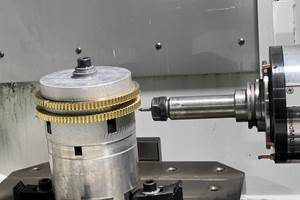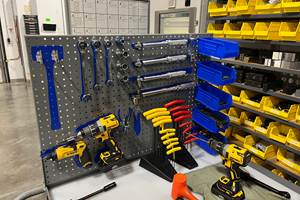Lights-Out Machining Gets Company Off To A Profitable Start
When Paul Brooke formed PZ Engineering (West Yorkshire, United Kingdom) in 2003, he immediately realized that lights-out, unattended machining would be an essential component of creating a viable company. He was also searching to equip his shop with machines from manufacturers that could provide local, responsive support.
Share




When Paul Brooke formed PZ Engineering (West Yorkshire, United Kingdom) in 2003, he immediately realized that lights-out, unattended machining would be an essential component of creating a viable company. He was also searching to equip his shop with machines from manufacturers that could provide local, responsive support.
Given Colchester’s Lathes offering of Storm series lathes—available in the United States through Clausing Industrial Inc. (Kalamazoo, Michigan)—and the close proximity of Colchester’s manufacturing plant, Mr. Brooke says that his basic concerns were answered. In addition, various packages were available to finance the machines—an attractive option for a one-person start-up company.
“I needed assurance that the machine I was to initially invest in—a Storm 220M with driven tools—not only met my budget, but was also reliable,” says Mr. Brooke. “Of course, the machine had to be capable of accommodating virtually any job I had to produce as well.”
Mr. Brooke emphasizes that the livelihood of his company essentially depended on the machine and the relative service support. Two years, three employees and four additional Colchester CNC machines later, Mr. Brooke is pleased with his initial decision.
Supplying valve industry components of various materials to a mainly local customer base in batch quantities varying from four to 18,000, PZ says it relies heavily on its trio of Storms, two 220M three-axis slant-bed CNC lathes and the latest acquisition, a Colchester five-axis T6MS mill/turn chucking center with subspindle. Two of the machines feature Storm MBF integrated 1000 bar feeds, which Mr. Brooke says he has found to be useful.
Like many people who run small engineering companies, Mr. Brooke spends a considerable amount of time dealing with business issues and company administration.
“Having two bar-fed lathes running regularly throughout the night with no one around enables me to cost-effectively produce large batches,” Mr. Brooke explains. He sets up all of the machines himself, performing the programming on the shop floor. “When I return in the morning, the components are ready to be loaded onto the vertical machining centers for finishing/secondary operations.”
Just last year, PZ added the five-axis Colchester T6MS turning center with a subspindle and one-hit milling and turning capability. Mr. Brooke describes this as being a critical move in enabling him to reduce cycle and leadtimes in the production of finished parts directly from the machine.
“In one instance involving a typical valve industry part, the 40-mm long component is produced on the T6MS in a fraction of the time customarily required when involving a sequence of main spindle rough turning, center drilling, finish turning, boring, threading, tapping and parting-off,” says Mr. Brooke.
With a maximum part length capacity of 450 mm between spindles, PZ takes advantage of the machine’s capability for in-phase radial C-axis rotation to enable in-cycle synchronized spindle ‘kissing’ at 30 m/min for ‘on-the-fly’ part exchange. The 12-station, all-driven, 3.7-kW, 30 VDI mill/turn turret services both spindles controlled by the Fanuc 18i-TB CNC, and it can maintain a positional accuracy to +0.005 mm, with repeatability within +0.002 mm. The part is then transferred to the subspindle, where rough turning, grooving and finish turning are performed.
The Colchester ‘lights-out’ package includes a bar feed and swarf conveyor, axis tool monitoring and sister tool replacement and production scheduling software. In-process gaging using Renishaw probes is also included to provide automatic off-set adjustment. Available as a ready-to-turn package, the T6MS has 52-mm bar capacity, and the main spindle is powered by 15-kW, 6,000 revs/min motor with a 5.5-kW, 6,000 revs/min subspindle.
Along with two vertical machining centers, the T6MS complements the existing pair of Storm 220Ms. These machines have larger 65-mm bar capacities, over-the-bed swings of 510 mm and maximum turning capacities of 260 mm by 540 mm long.
One of the 220M machines and the T6MS turning center are fitted with MBF 1000 bar feeds, which are said to play an integral role in the machines’ capability of providing high output. Because the bar feed is integrated with the machine’s Fanuc CNC system from which it is programmed, the result is optimized job change-over routines and reduced setup times, says the company. The number of parts per bar can be programmed at the control. The unit’s design characteristics of short gap to the spindle and the length of support the material receives in the headstock can also eliminate vibration and pick-up on feed liners.
PZ’s installation marked the first in the United Kingdom of the Colchester T6MS. In fact, Mr. Brooke purchased the prototype model. He voices one regret—that he did not wait for the larger capacity model to be launched so that his company could pursue larger work.
Related Content
Increasing Productivity with Digitalization and AI
Job shops are implementing automation and digitalization into workflows to eliminate set up time and increase repeatability in production.
Read MoreFour-Axis Horizontal Machining Doubles Shop’s Productivity
Horizontal four-axis machining enabled McKenzie CNC to cut operations and cycle times for its high-mix, high-repeat work — more than doubling its throughput.
Read MoreHow to Accelerate Robotic Deburring & Automated Material Removal
Pairing automation with air-driven motors that push cutting tool speeds up to 65,000 RPM with no duty cycle can dramatically improve throughput and improve finishing.
Read MoreTranslating a Prototyping Mindset to Production
The experimental mindset that benefited BDE Manufacturing Technologies as a prototype job shop has given it an adaptable edge as a production facility.
Read MoreRead Next
5 Rules of Thumb for Buying CNC Machine Tools
Use these tips to carefully plan your machine tool purchases and to avoid regretting your decision later.
Read MoreSetting Up the Building Blocks for a Digital Factory
Woodward Inc. spent over a year developing an API to connect machines to its digital factory. Caron Engineering’s MiConnect has cut most of this process while also granting the shop greater access to machine information.
Read MoreRegistration Now Open for the Precision Machining Technology Show (PMTS) 2025
The precision machining industry’s premier event returns to Cleveland, OH, April 1-3.
Read More


















.jpg;maxWidth=300;quality=90)















